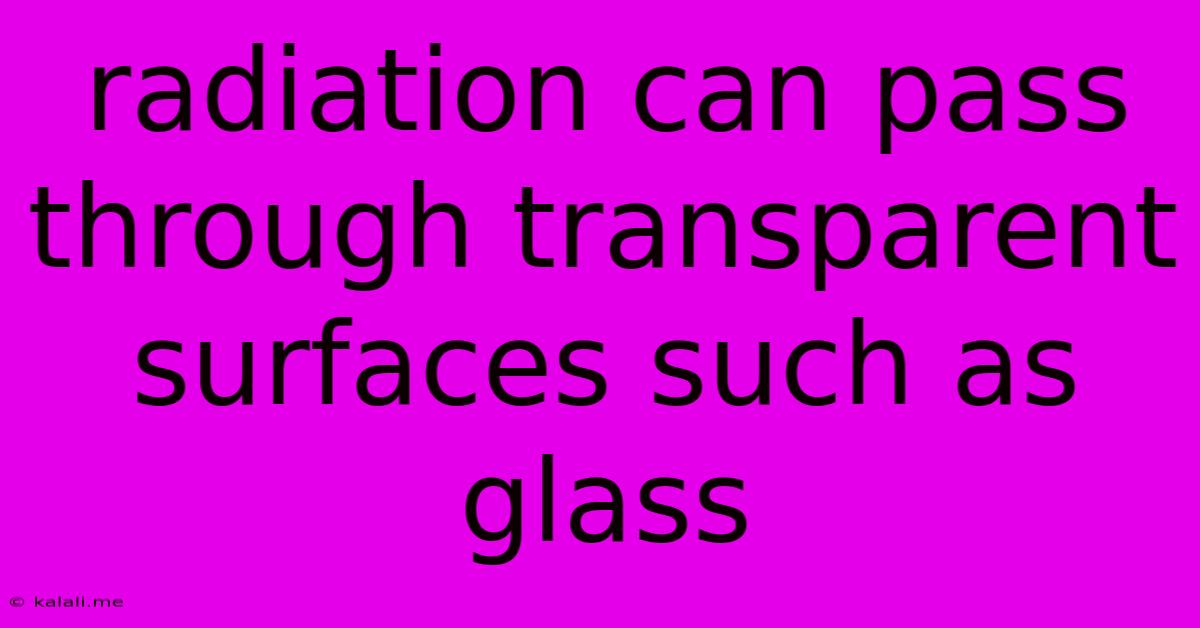Radiation Can Pass Through Transparent Surfaces Such As Glass
Kalali
May 22, 2025 · 3 min read

Table of Contents
Radiation: Does it Really Pass Through Glass? A Look at Transparency and Shielding
Meta Description: While glass is transparent to visible light, its interaction with other forms of radiation is more complex. This article explores how different types of radiation interact with glass, explaining why it offers varying levels of protection.
Many people assume that because glass is transparent to visible light, it's also transparent to all forms of radiation. This is a misconception. The truth is more nuanced, depending heavily on the type of radiation and the specific properties of the glass itself. Understanding this difference is crucial for ensuring safety in various settings.
What is Radiation?
Before delving into glass's interaction with radiation, it's important to define what radiation is. Radiation encompasses the emission or transmission of energy in the form of waves or particles. This energy can manifest in many forms, including:
- Electromagnetic Radiation: This includes visible light, ultraviolet (UV) light, infrared (IR) light, X-rays, and gamma rays. These are all forms of light, differing only in their wavelengths and energies.
- Particle Radiation: This includes alpha particles, beta particles, and neutrons. These are subatomic particles that carry energy and can cause ionization.
How Glass Interacts with Different Types of Radiation
Glass's interaction with radiation varies significantly depending on the type of radiation:
- Visible Light: Glass is highly transparent to visible light, allowing it to pass through with minimal absorption. This is why we can see through windows.
- Ultraviolet (UV) Radiation: Glass partially blocks UV radiation. While standard window glass blocks most UVB radiation, it's less effective against UVA radiation. This is why prolonged sun exposure through a window can still cause sunburn. Special UV-blocking glasses are available that offer greater protection.
- Infrared (IR) Radiation: Glass also partially blocks IR radiation, which is why it helps keep buildings warmer in winter and cooler in summer. However, this effect is less pronounced than its UV blocking.
- X-rays and Gamma Rays: Glass offers minimal protection against high-energy X-rays and gamma rays. These forms of radiation possess enough energy to pass directly through the glass with little interaction. Lead glass, which contains a higher concentration of lead, is used in applications requiring protection from these types of radiation.
- Alpha, Beta, and Neutron Radiation: Glass provides reasonably good protection against alpha radiation, as these particles are relatively large and heavy, making them easily absorbed. Beta particles can penetrate glass to some extent, while neutron radiation can pass through, requiring much denser shielding materials.
The Role of Glass Composition
The specific composition of the glass also influences its interaction with radiation. Lead glass, for example, due to its high lead content, is significantly more effective at blocking X-rays and gamma rays than standard soda-lime glass. The thickness of the glass also plays a role; thicker glass will generally offer better shielding.
Applications and Safety Implications
Understanding the varied interaction between radiation and glass is crucial in several applications:
- Radiation Safety: In medical and industrial settings where radiation is used, appropriate shielding is essential to protect personnel. While glass may provide some level of protection against certain types of radiation, it's rarely sufficient on its own for high-energy radiation sources.
- Building Design: The use of glass in buildings needs to consider its ability to block harmful UV radiation and its impact on thermal insulation.
- Scientific Instruments: The properties of glass are utilized in scientific instruments designed to work with radiation. For example, specialized glasses are employed in radiation detectors.
In conclusion, while glass is transparent to visible light, its transparency to other forms of radiation is dependent on both the type of radiation and the specific properties of the glass. For effective shielding from high-energy radiation, more robust materials are necessary. This understanding is crucial for ensuring safety and effective design in various contexts.
Latest Posts
Latest Posts
-
How To Get Super Glue Off Your Fingers
May 22, 2025
-
Gaucs To Pick Patterns From Time Series
May 22, 2025
-
What Does No Guard Do In Pokemon
May 22, 2025
-
X 2 1 X 1 X 1
May 22, 2025
-
How Many Cups Is A Box Of Powdered Sugar
May 22, 2025
Related Post
Thank you for visiting our website which covers about Radiation Can Pass Through Transparent Surfaces Such As Glass . We hope the information provided has been useful to you. Feel free to contact us if you have any questions or need further assistance. See you next time and don't miss to bookmark.